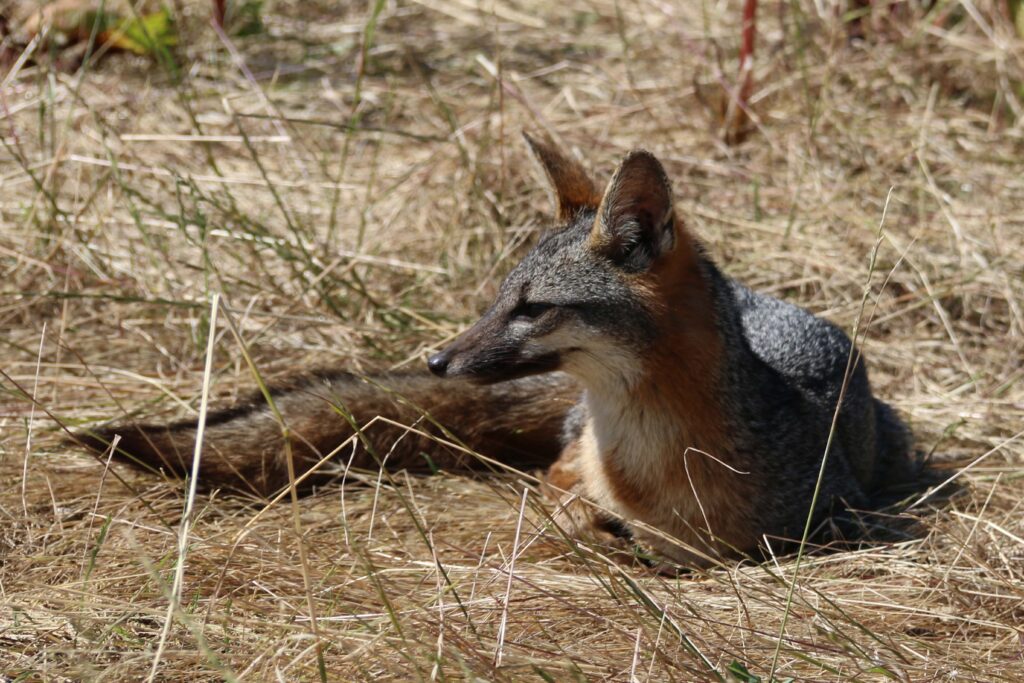by William C. Leikam
President, CEO & Co-founder, Urban Wildlife Research Project
Wildlife Populations Plummet, Part 1
In taking a trail camera survey of the wildlife at the Palo Alto Baylands Nature Preserve (opossums, gray fox, red fox, beaver, skunk, raccoon, muskrat, woodrat, coyote, jack rabbit, and cottontail rabbit) there has been a significant shift in some of their populations. In 2016 we saw the die-out of some 25 gray foxes due to canine distemper, the latter of which was officially confirmed by the California Department of Fish and Wildlife’s chief veterinarian. When asked where it came from, she said, “It’s endemic to California.” If we take a look at this from 2021 to 2023 it’s possible to see these shifts. In Part II of this series, we will discuss what all this means for the ecosystem in the Palo Alto Baylands.
Diseases: Gray Fox, Raccoon and Skunk
Gray Fox (Urocyon cinereoargenteus townsendi)
In 2022, we had two gray foxes occupying the region from Matadero Creek, over to the Regional Water Quality Control Plant. Throughout this territory they prayed on woodrats, jack rabbits and cottontail rabbits, insects and when in season fruits, thus significantly helping to keep the ecosystem in balance. They control stomach problems by eating a particular kind of grass that grows at the baylands and elsewhere. Recently, there has been a decline in the number of gray foxes from two to zero due to canine distemper. Distemper is a virus that attacks the neurological system, the gastrointestinal system, and the respiratory system all at the same time. In addition to distemper, these foxes can also suffer from parvovirus, heartworm and in rare instances rabies. (Source)
Raccoon (Procyon lotor)
During 2022, the population of raccoons at the Regional Water Quality Control Plant (RWQCP) was robust with both male and female raccoons and their young, often called cubs. In early 2022, I counted a total adult and cub population of 37 raccoons of all ages. From time to time, the number passing my trail cameras varied slightly because some of the raccoons had a range that extended to the golf course and to Matadero Creek. In early 2023 I saw a gradual decline in the number of raccoons around the RWQCP until today there is only a single raccoon occupying this territory. Viral diseases in raccoons include rabies, canine distemper, raccoon parvovirus, infectious canine hepatitis, and pseudorabies. (Source)
The raccoon population at Matadero Creek has been on a steady decline over a period from early 2023 to the present. Down in the overflow channel along the creek, between channel markers #14 and #15, there is a distinct odor of a decaying animal. Given the “size” of the odor it’s likely a raccoon. As well, there are two young raccoons. When they first appeared along the creek, mama raccoon taught them survival, but over the past three months, she has not been with them as they forage alone. She likely died from canine distemper as that is the deadliest of all the viruses that raccoons can get.
Striped Skunk (Mephitis mephitis)
The baylands never really had a very large population of striped skunks, but in the early days, well before 2022, in one area behind the RWQCP, there were numerous skunks living in a region that I called Skunk Hill. More recently in 2024, Animal Control picked up a skunk from near the RWQCP. Presently, I have seen only one skunk and when it passes my camera its tail is hung low and the skunk rather shuffles along indicating that the skunk is not well. Viruses include Canine Hepatitis, Canine Distemper, Intestinal Roundworms, Leptospirosis, and Rabies. (Source)
A common thread runs through these three populations: Canine distemper. And if we return to the CDFW’s veterinarian’s comment that it appears to be endemic, then maybe here in the Baylands distemper is simply a part of the landscape. Regarding the skunk and raccoon populations, according to Animal Control, “…we suspected canine distemper as well. We’ve had about a dozen calls for skunks recently in the Byxbee [Park] area with signs of distemper.”
In Part 2 of this examination, we will see how such die-out’s impact on the Palo Alto Baylands Nature Preserve. Scientifically, it’s called a tropic cascade.
Gray Fox Population & General Health
As of this date, there are no gray foxes in the Palo Alto Baylands Nature Preserve. However, our trail cameras are still rolling, and we are optimistic a new pair will someday move into the undefended territory.
UWRP News & Updates
On March 20, 2024 Bill attended a gathering of 3rd graders at the Starbright School in Campbell, California. The students gave presentations on conservation and ecology. One student had done her project on the Urban Wildlife Research Project. Because of this, Bill was asked to attend. At the end of the presentations, Bill gave a short talk. The school’s Director of Operations Anastassia Ku wrote, “Thank you very much for finding time in your schedule to attend our event and for giving a little speech to our young students. They were so excited afterward that they could not stop talking the entire day that they got to meet the “Fox Guy” and that the Fox Guy came to see their presentations. As teachers, we are thrilled to see the excitement like this because once the initial excitement subsides, the ideas begin to flow.”
Upcoming Events
There are a couple of tabling events occurring in celebration of Earth Day.
On Saturday April 20, we will be displaying our wares at Safari West.
Then on April 21st, we will be at CuriOdyssey.
Come on by and introduce yourself!
Friends of Wildlife
Ways To Help Wildlife At Home & In The Community

Wildlife Tip – Free Wildflower Seeds
The Santa Clara Valley Chapter of the California Native Plant Society is promoting biodiversity by giving free wildflower seeds to new native plant gardeners in their chapter area (Santa Clara and San Mateo counties) to re-energize the ecosystem in their home gardens.
Find out more here: Wildflower Ambassadors
And join the NextDoor group to learn more tips!

Community Involvement
A large unprotected S.F. Bay Area wetland may be paved over for a 400+ unit luxury housing development (never mind the fact that it sits on a flood plain). Community members are joining together to advocate for a different vision – permanent habitat protection as part of the Don Edwards National Wildlife Refuge. Learn more and sign the petition here: Save Newark Wetlands
Looking for more ways to engage? Check out the resources below

Have you seen us on TV? Catch our latest feature & interview with Bill, produced for NorCal Public Media’s Bay Area Bountiful

Today, Bill is the world’s leading authority on the gray fox. This book is an account of his experiences among the gray foxes of the Baylands, a tale of life and death, of growth and loss. Stay for a while and go exploring with the Fox Guy. Find it today at Barnes & Noble or DiAngelo Publications.

Be sure to watch our video documentary featuring UWRP’s participation in the global trail camera exhibit, Triggered By Motion













